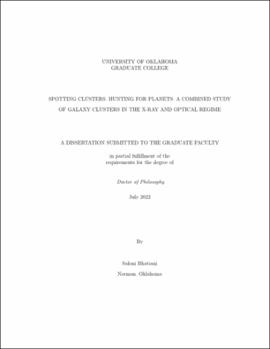| dc.contributor.advisor | Dai, Xinyu | |
| dc.contributor.author | Bhatiani, Saloni | |
| dc.date.accessioned | 2022-08-02T19:31:17Z | |
| dc.date.available | 2022-08-02T19:31:17Z | |
| dc.date.issued | 2022-08 | |
| dc.identifier.uri | https://hdl.handle.net/11244/336454 | |
| dc.description.abstract | Observational studies of the distribution of galaxies in the Universe reveal inhomogeneity and structure on Mpc and larger scales. Galaxy clusters are the largest gravitationally bound structures containing a virialized congregation of galaxies; therefore, studying them is essential for understanding the constitution and assembly history of these systems and probing the large-scale structure of the Universe. The Swift AGN and Cluster survey is a serendipitous X-ray survey aimed at building a large X-ray-selected cluster catalog with $\sim 1000$ cluster detections expected by its final release. In this thesis, I perform an optical analysis of 348 (out of 442) X-ray selected cluster candidates from the Swift cluster catalog using multi-band imaging from MDM 2.4m and the Pan-STARRS survey for the northern sky, and CTIO 4m and DES for the southern sky. I report the optical confirmation of 109 clusters with $> 3 \sigma$ galaxy over-density with photometric redshift estimates extending up to $z\sim1$. The Swift survey is nearly complete for $z\leq 0.3$ and $85\%$ complete for $z \leq 0.5$. The undetected clusters are possibly high redshift clusters with $z >0.8$ that warrant follow-up observations in the near-infrared. Furthermore, I also study the scaling relations between the X-ray and optical cluster mass observables and the offset distribution for all the optically verified SACS clusters and find them to be in agreement with other studies in literature.
Another facet of my dissertation involves using quasar microlensing to probe the intracluster region of a galaxy cluster. I employ this novel technique to exert effective constraints on planet-mass objects in two extragalactic systems, Q J0158-4325 and SDSS J1004+4112, by studying their induced microlensing signatures. Chandra observations for these two gravitationally-lensed quasars reveal variations of the emission line peak energy, which can be explained as microlensing of the FeK$\alpha$ emission region surrounding the supermassive blackhole induced by planet-mass microlenses. To corroborate this, I have performed microlensing simulations and developed an edge detection algorithm to determine the probability of caustic transiting events. Comparison with the observed rates has yielded constraints on the substellar population, with masses ranging from Lunar to Jovian mass bodies within these galaxy or cluster scale structures. These results suggest that unbound planet-mass objects are common in galaxies, and these are surmised to be either free-floating planets or primordial black holes. These are the first-ever constraints on the substellar mass distribution in the intracluster light of a galaxy cluster. This analysis yields the most stringent limit for primordial black holes at the mass range. | en_US |
| dc.language | en | en_US |
| dc.subject | Physics | en_US |
| dc.subject | astronomy | en_US |
| dc.subject | galaxy | en_US |
| dc.subject | galaxy cluster | en_US |
| dc.subject | gravitational lensing | en_US |
| dc.subject | microlensing | en_US |
| dc.title | Spotting clusters, hunting for planets: a combined study of galaxy clusters in the X-ray and optical regime | en_US |
| dc.contributor.committeeMember | Baron, Edward | |
| dc.contributor.committeeMember | Chapple, Constance | |
| dc.contributor.committeeMember | Kao, Chung | |
| dc.date.manuscript | 2022-07-28 | |
| dc.thesis.degree | Ph.D. | en_US |
| ou.group | Dodge Family College of Arts and Sciences::Homer L. Dodge Department of Physics and Astronomy | en_US |
| shareok.orcid | 0000-0002-9044-9383 | en_US |
